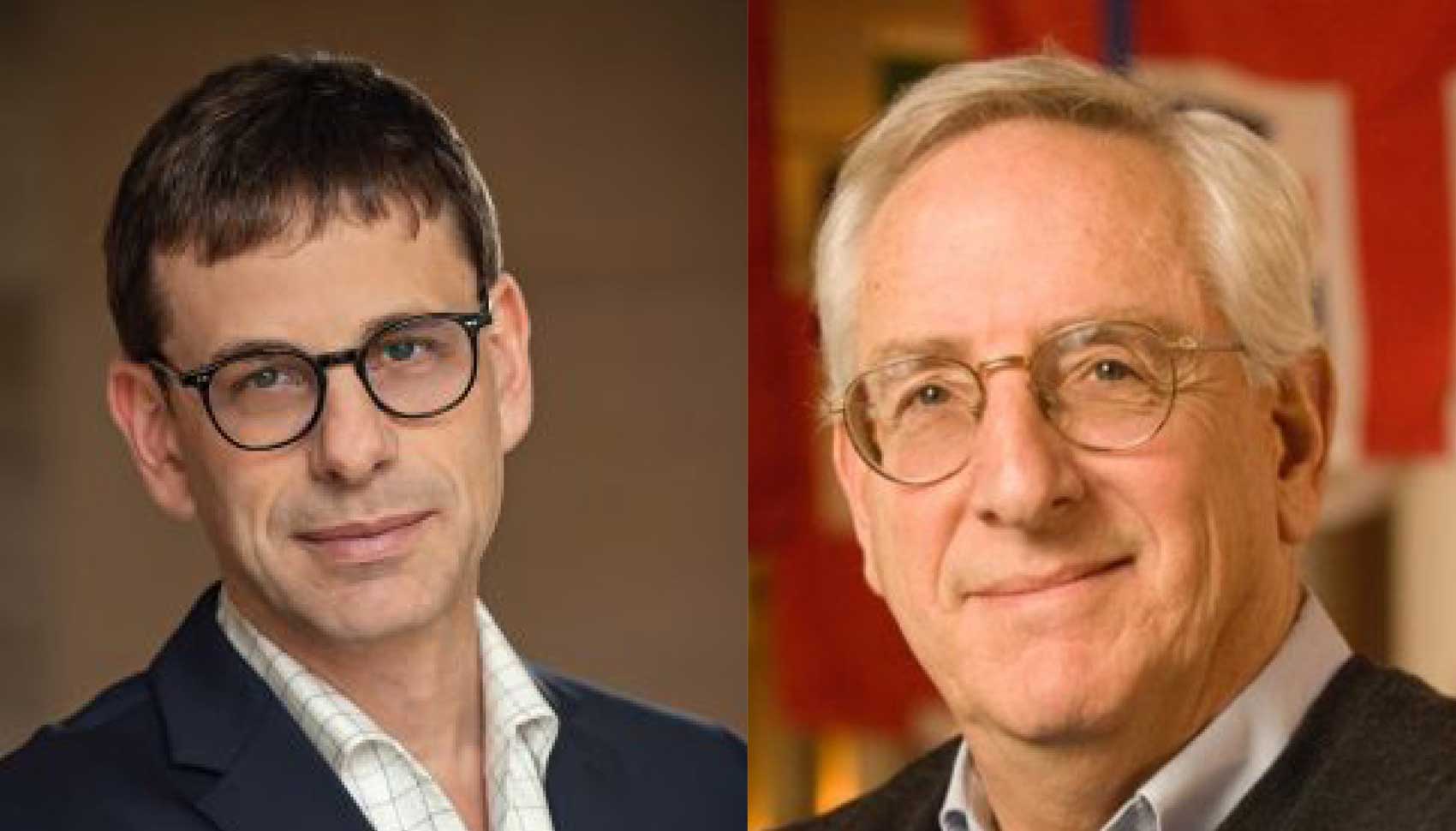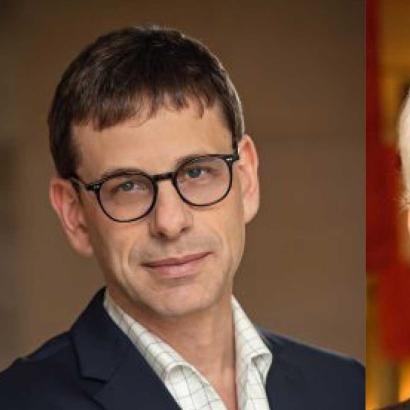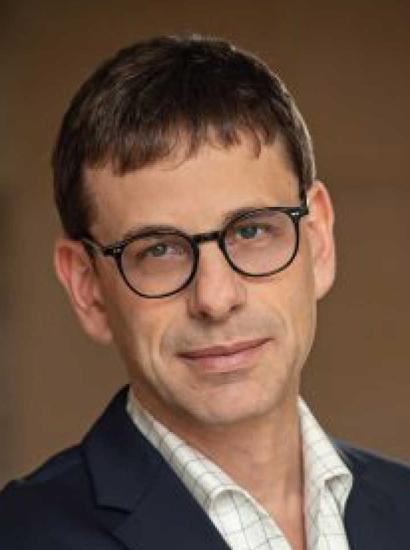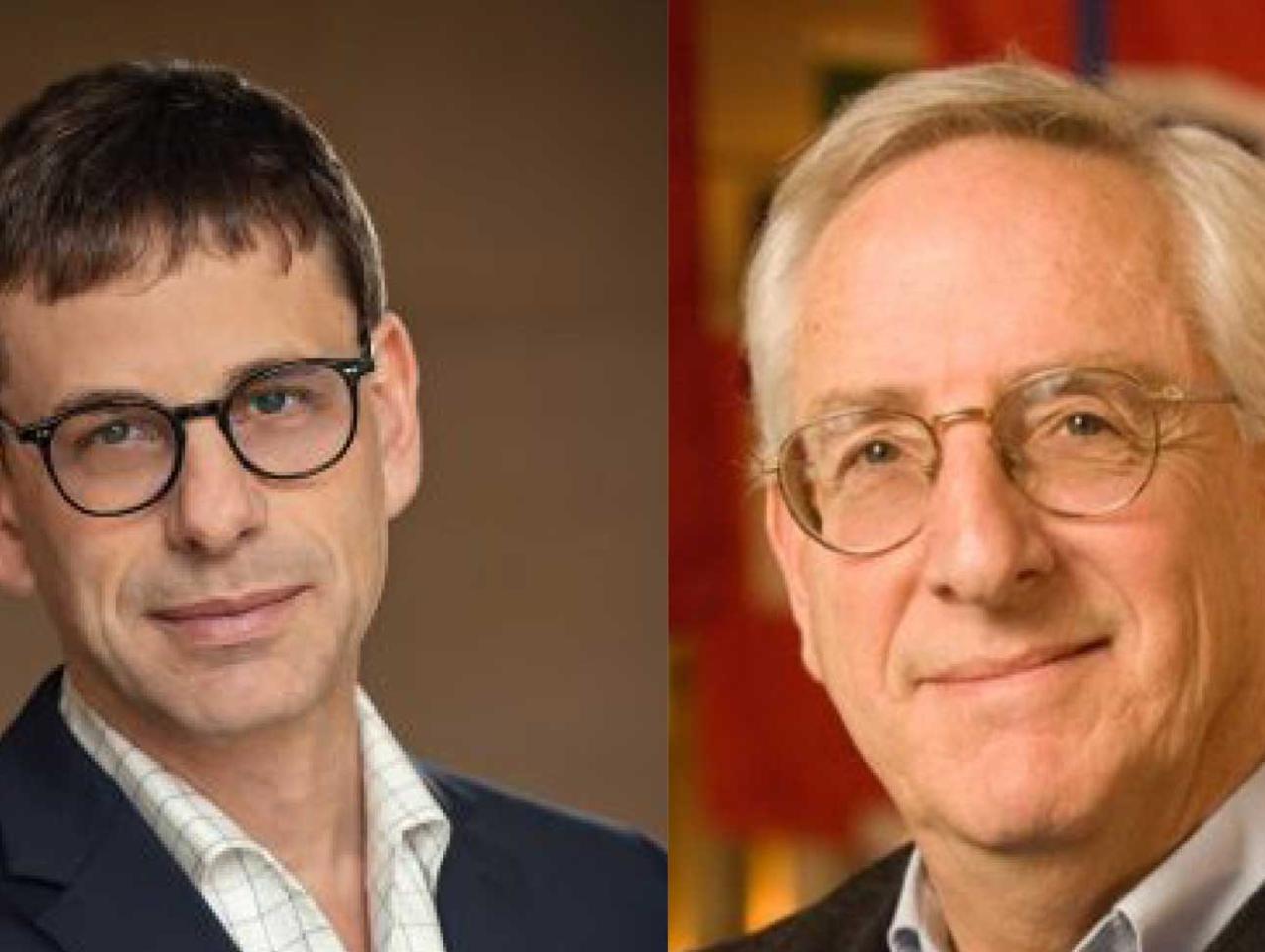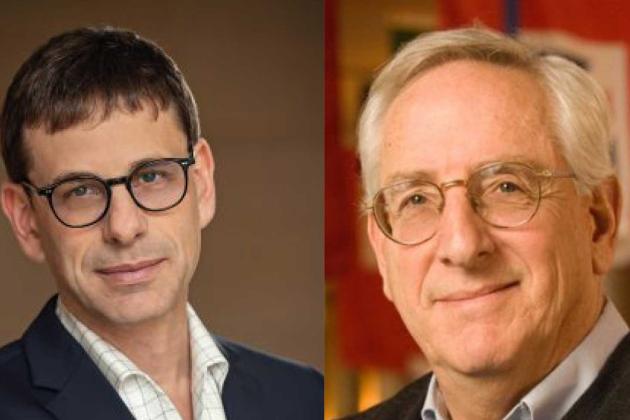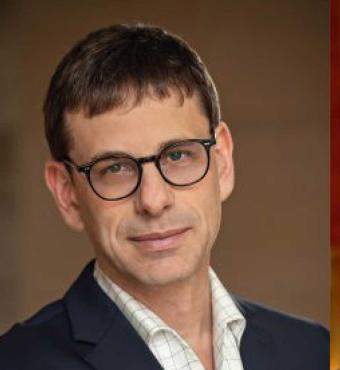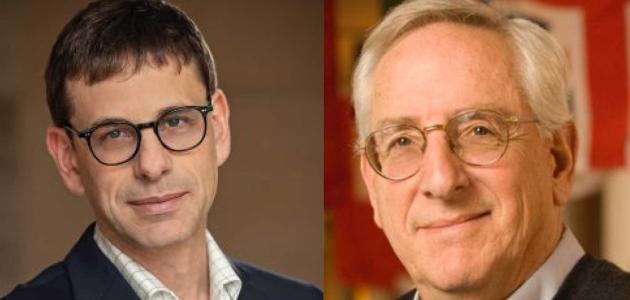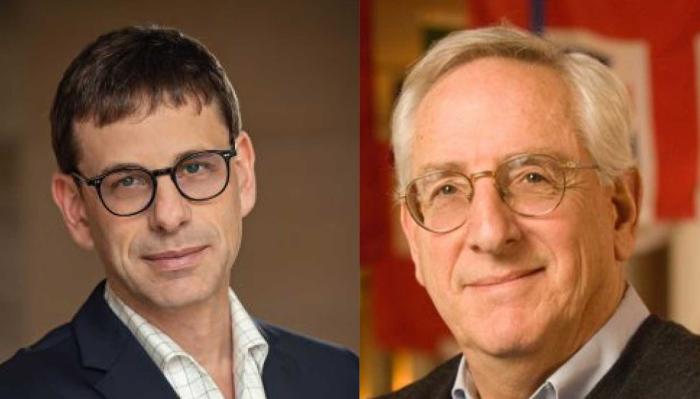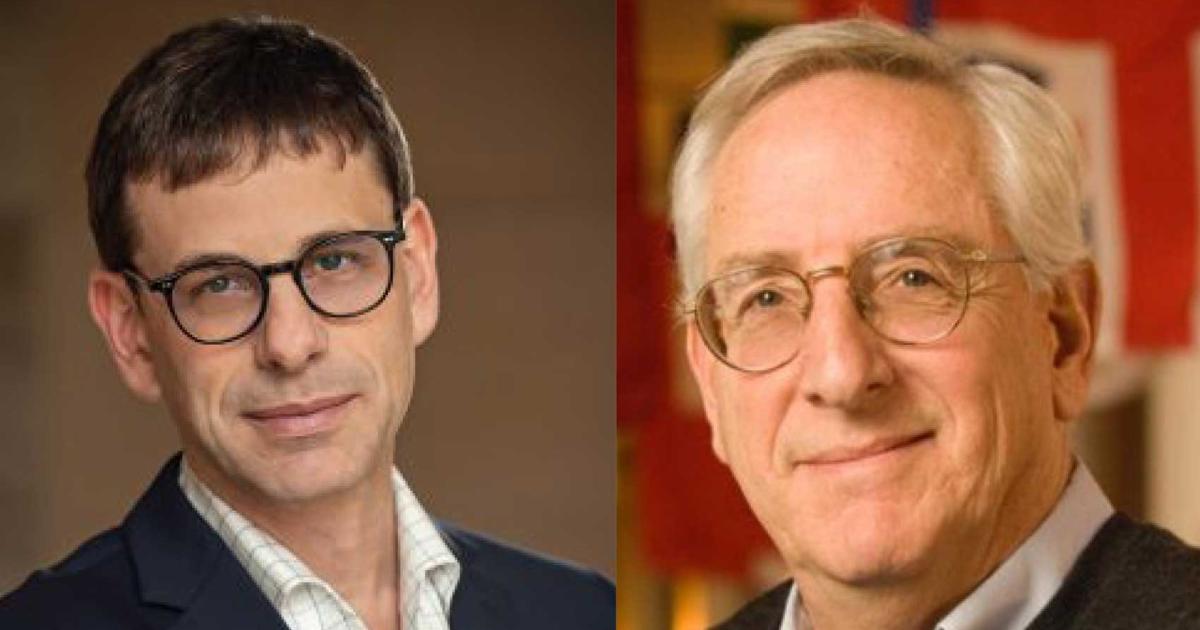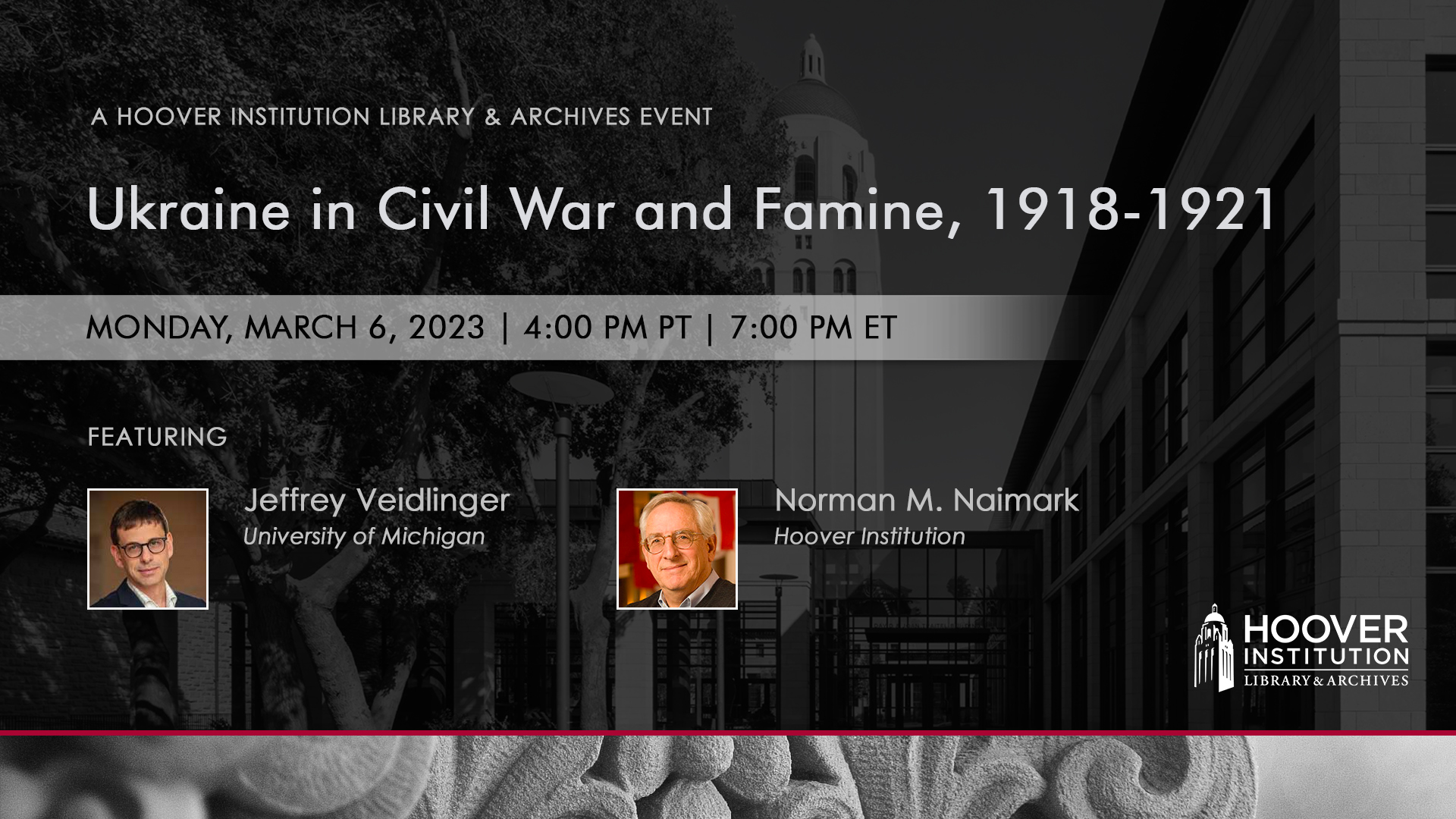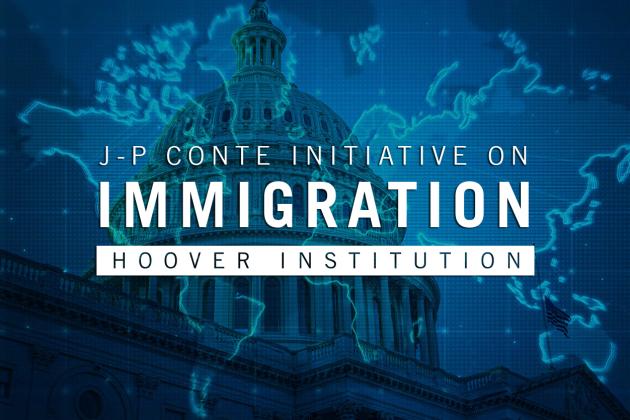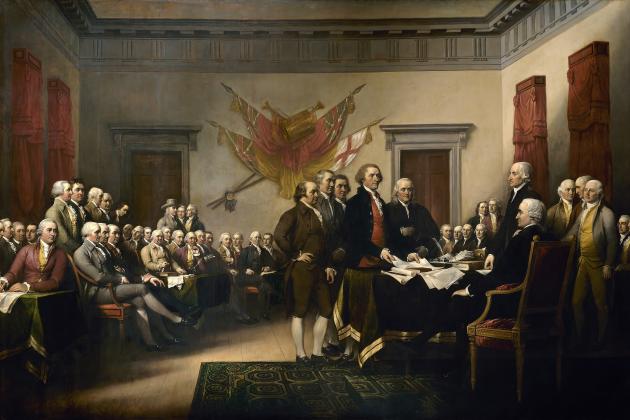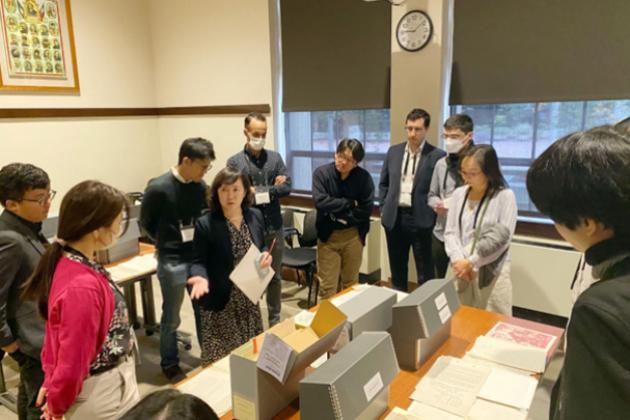

Join Jeffrey Veidlinger and Norman Naimark for a conversation about events in Ukraine in the years following the 1917 Russian Revolution. In this period of civil war, anarchy, and famine, Ukraine was overrun by successive armies of Germans, Russian Whites and Reds, and Ukrainian nationalists, as well as an assortment of bandits and outlaws. In the turmoil, more than one hundred thousand Jews perished. Most were victims of pogroms—ethnic riots—murdered by peasants, townsmen, and soldiers or left to die of famine, exposure, and disease.
In researching his 2021 book, In the Midst of Civilized Europe, about this largely forgotten episode of violence and ethnic cleansing directed against Jews, Veidlinger drew upon newly discovered witness testimonies, trial records, and official orders. He will discuss his research and consider to what extent the pogroms of 1918–1921 help us understand how the Holocaust happened.
The Hoover Institution Library & Archives, the Department of History, and the Taube Center for Jewish Studies at Stanford University are co-sponsors for this event.
>> Eric Waken: Hi, everyone. Let me welcome you to tonight's talk in the Bread + Medicine Speaker Series. My name is Eric Waken. I'm the deputy director of the Hoover Institution and the head of its library and archives. And I just want to contextualize this event and what the library and archives and the institution does a bit.
Mr Hoover, who founded this institution as the Hoover War Library 100 some odd years ago, set it to do many things. One of them is it should be more than, quote, a mere library, unquote. And by that he meant people should come in and study the records that have been collected in this world class library and archives that started almost 20 years before the national archives, but also that scholarship and activities and things should take place around the subjects of interest to Mister Hoover, which were war, revolution, and peace writ broadly.
And that's what the collecting focus of the institution has been over the years. And I in honor of Mr Hoover's vision, we bring together people to talk about the collections, talk about the scholarship around the activities of the 20th and 21st century that Mr Hoover said we should be focusing on.
We're still doing that in honor of his vision. I also want to thank the director of the institution, Condoleezza Rice. The donors who support what we do, they're called overseers and they're our board of directors. Hoover is almost entirely privately funded. It's really entirely privately funded from donors and a little tiny bit of money from Stanford University.
So without the support of our generous donors, we would not be able to do any of our programming, any of our collecting, and any of our scholars here. So with that, I'm gonna do the proper introduction to my colleague, Anatol Shmelev, who's the Robert Conquest Curator for Russia and Eurasia, who will introduce our guests and kick the thing off.
So thank you so much for being here today.
>> Anatol Shmelev: Thank you, Eric, and welcome, everyone, to this event in the Bread + Medicine Speaker Series entitled Ukraine in Civil War and Famine, 1918 to 1921. This series complements the exhibition now on view at the Hoover Tower at Stanford University and its corresponding online exhibition.
And we're going to share the link for that online exhibition in the chat at the end of the program. I also wanted to point out this is going to be a hybrid event, which means that we have a live audience here in the hall, and we also have many more people online.
And I want to encourage everyone online to ask your questions at the end and share them with us, because we'll have plenty of time for discussion. And we definitely want to hear from you, and we don't want you to feel left out at all. The talk today is going to focus on events in Ukraine following the 1917 revolution that brought down the russian empire, overrun by successive armies of Germans, russian whites and Reds, Poles and ukrainian nationalists representing various governments, as well as anarchists and assorted bandits and outlaws.
This period saw the murder of over 100,000 Jews. Most were victims of pogroms, ethnic anti semitic riots murdered by peasants, townspeople and soldiers. Countless more were left to die of famine, exposure, and disease. Our speakers today are Jeffrey Veidlinger, who is the Joseph Brodsky Collegiate Professor of History and Judaic Studies at the University of Michigan.
His latest book is entitled In the Midst of Civilized Europe, the Progroms of 1918-1921 and the Onset of the Holocaust. It was a finalist for the Lionel Gelber Prize, a finalist for the National Jewish Book Award, a Times of London Book of the Week, and a Kirkus Top Nonfiction Book of 2021.
Professor Veidlinger is also the author of award winning books entitled the Moscow State Yiddish Theater, Jewish Culture on the Soviet Stage, as well as Jewish Public Culture in the Late Russian Empire and In the Shadow of the Shtetl, Small-Town Jewish Life in Soviet Ukraine. He was the director of the Frankel Center for Judaic Studies from 2015 to 2021 and director of the Borns Jewish Studies program at Indiana University from 2009 into 2013.
Norman Neymark, many of you know well because he's a professor here at Stanford University. He's the Robert and Florence McDonald professor of East European Studies, a senior fellow of Stanford's Freeman Spogli Institute, and a senior fellow at the Hoover Institution of Stanford University. Professor Neymark is the author of numerous works of history, including the critically acclaimed volumes the Russians in Germany, the History of the Soviet Zone of Occupation 1945 to 49.
Fires of Hatred, Ethnic Cleansing in 20th Century Europe, Stalin's Genocides, and his latest book, Stalin and the Fate of Europe, the Post-war Struggle for Sovereignty, published by Harvard University Press. With this, I turn it over to Professor Veidlinger, and Professor Neymark will then offer commentary and remarks, and after that we'll have question and answers.
So, please.
>> Jeffrey Veidlinger: Thank you, everybody, for coming, and thank you, Eric, thank you, Anatol, and thank you particularly, Bert, for organizing this. And thank you, Norman, for commenting on it. So I'm going to talk a little bit today about the book that I recently wrote. There we go.
The book that I recently wrote called In the Midst of Civilized Europe, the Pogroms of 1918 to 1921 and the Onset of the Holocaust. And really, it's about what happened in Ukraine during the period of 1918 to 21, and particularly about what happened to the Jews in Ukraine during this period, in which Jews were targeted by all sides in a horrendous conflict and a horrendous war, but sometimes overly, simplistically called the civil war, but really is more a series of revolutionary wars in Ukraine during this period.
And I'll begin to by talking about this oral history project that I was a part of from about 2002 to 2010. My colleague Dovberg Koehler, who you see there, and I would go to Ukraine about twice a year or so and interview elderly yiddish speakers in the small towns in which they were born.
And it was predominantly a linguistic project. We were looking for people to talk to us in Yiddish to understand how Yiddish dialects changed over time. But there was a portion of the interviews where we asked them to tell us about their lives, and to tell us the story of how they survived communism, how they survived the Holocaust.
And in these stories, I started to hear repeatedly people talking about the pogroms of 1918 to 1921. The people that we interviewed were generally elderly. Many of them had been born in the 1910s and were children at the time of the russian revolution and of the civil wars that followed or the revolutionary wars that followed and told us these horrendous stories about their experiences during that time.
And as I was writing the book in the shadow of the shtetl, I started thinking already about this story of the pogroms and to tell the story of the pogroms in the next book. So I'm going to play you. I believe the, yeah. So here's a few of the interviews I'm gonna play.
We have a website set up that's ahaim.com that you can check out. I'm going to play you a few clips from the interviews to begin with to talk a little bit about the stories that we heard from 1918 to 1921. So the first one is a story told by Naum Gaivicker.
And you'll hear in the interview that I'm going to play you, it's actually his wife who does most of the talking as he sits there nodding along. He was born in 1912 in the town of Proskurov, which witnessed a terrible pogrom in 1919 when he was seven years old.
And he talks about his memories of that pogrom. And I want to play you the clip, and then I'll play you another clip of another pogrom. And we can hear how these so called pogroms, which can mean anything from ethnic violence, from a type of race riot of some members of the town, peasants from the surrounding countryside often coming into the town and killing Jews.
To an organized military action against Jewish citizens of a town. And what he's describing is going to be a military action. There was an attempted Bolshevik revolution in the town of Proskurov, and it was very quickly put down within hours on February 15, 1919. And immediately after the revolution was put down, a unit fighting on behalf of the Ukrainian National Republic, which was a state that had only just been established about six weeks earlier, came into town.
And interpreted a call to put down the revolution as a call to massacre Jews and went door to door rounding up Jews and killing them. So I'm going to play you a bit of him, of his wife talking about it, and of him talking a little bit as well about what he endured.
It's in Yiddish, but there's subtitles. You can read.
>> Jeffrey Veidlinger: Okay, so there's a lot in that narrative that I could talk about, including the fact that he's not really the one telling it, but that's his spouse telling it. But what you hear and what he describes is really a military action of this unit of the ukrainian army going into town and rounding people up in the major streets.
My colleague Dov-Ber Kerler asks what the name of the street was, and you can hear him say Sobornaya, which means Church Street. Obviously, this is a major street in town. It's the main street in town where most of the Jews were living. And we know a lot about this pogrom because it's been heavily documented.
And what I'm showing right now is a list of the names of those killed in this pogrom, which took place over the course of 4 hours on February 15, 1919. And you can see this is the last page of a list, and the last number is 911. So it documents the names and ages of 911 people who were killed that day.
This is the conservative estimate because we actually have the names and ages, but estimates go as high as about three times that many eventually died from the pogrom. Maybe they died subsequently of their wounds or they died of a disease as a direct result of the pogrom. So it was clearly a very large pogrom and possibly the largest single pogrom, the largest single anti-Jewish action of any kind in Jewish history to date.
Here you can also see further documentation of what took place in the town on that day. On one side, it's a questionnaire that was given to people in the town, that they went door to door and gave questionnaires to Jews in the town, asking who was killed in this household.
And you can see on this page, there's the names of a few people, ranging in age from 9 till 41. And the other is a description, a little bit more of a narrative description, a questionnaire asking people how they experienced the pogrom. February 1919. There was also a memorial book published about the pogrom in 1924 called Hurbn Praskurov, the destruction of the town of Praskorov.
And this is the front piece of the book. I found this interesting, actually. I start my book with this memorial book because it's really reminiscent of the memorial books that were published in the aftermath of the Holocaust. And it made me think about connections between these pogroms and the Holocaust, and connections that the informants, that the people we interviewed often made themselves.
So that's one style of pogrom perpetrated by a military. By a unit of a military organization in town to put down a Bolshevik rebellion. I wanna play you another narrative of a different pogrom. This one took place in the town of Tulchyn in Podolia. And actually, this what I have here is a map of all of the pogroms that we were able to document.
We documented about 1000 separate pogroms in about 500 different locales. And the circles which you can't see all that well in this light, but are in proportion to the amount of people killed in each incident. In total, we have the names of about 40,000 people who were killed, and the Soviets who took over in 1921, conducted a little bit of a statistical analysis and came to the conclusion that those names include about a third of the total victims, which is how we get to the figure of 100,000 for the total number of jewish victims killed during this violence.
So the next clip I wanna show you is, again, from the Tulchyn pogrom. And this is a fellow by the name of Nisen Yurkovetsky. And he's going to describe to us how when he was two years old, a little bit less than two, actually about 18 months old, his entire family was killed in a pogrom, and he was left in a mass grave.
A polish priest was then walking by later, he says, and found him and returned him to a grandfather who had survived. And he's going to roll up his sleeve and show us a scar on his arm where the bullet. Where he says. Anyway, that the bullet that killed his mother ricocheted off his arm.
As she was being killed. So I'll play you that narrative.
>> Jeffrey Veidlinger: Yeah. Okay again, in this narrative, there's a lot that we could talk about, including that he obviously is not telling it from his own memory. He was 18 months old. He has subsequently heard the story. But this is a very different type of pogrom than the pogrom described in Proskurov.
In Proskurov, it took place over the course of four hours, and 900 people were killed, and the perpetrators were a military unit. In this case, he says, the pogrom lasted eight days and the perpetrators were the Yakovic gang, or the Yakovic group of bandits. And who are the Yakovic bandits?
They appear to be people from the neighboring countryside, Ukrainians from the neighboring countryside who came into town to raid it and kill Jews in the process. We also like the Proskurov pogrom, we're not relying solely upon oral history. We also have documentation, contemporary documentation, that talks about the same pogrom.
This is from a yiddish testimony dated 1920. And what I want to point out in it is that you can see the name Yakovic. You can see it's written there in Russian in parentheses. And there's the Yiddish. It's a similar narrative, talking about the Yakovic gang. Yakovic who was the son of an officer and was a local peasant who came into town and perpetrated these atrocities.
This narrative continues to say that the pogrom lasted for, he says here, an entire day, he says, for 24 hours in Yiddish. But then he says, they came back the next day and continued the pogrom. So the eight day story seems to be confirmed. And then in this narrative, he also talks about a delegation of polish priests that came into town and ended the pogrom.
So it's very different than a military pogrom, because these are, again, local peasants that everybody knows, and everybody knows the names of the perpetrators, the Yakovic gang. And they're also able to be stopped, that this is, the priest can come in, and he can say at a certain point in time, okay, everybody go home.
And people sure enough, do seem to go home in this narrative, you can see, he says, 500 people were killed in this pogrom. I think this is an overstatement for this pogrom, because we have about 30 names. So I don't know how 30 names gets to 500 people.
But in this particular narrative, he claims that 500 people were killed in the pogrom. So those are two extremes of the types of pogroms that we're talking about. And then there's everything in between of these 1000 or so incidents that took place in 1918 to 1921. And I want to talk about who the perpetrators were and why this was going on.
But first, I want to give you a little bit more background on the town of Tulchyn by looking at this chart of occupational diversity in the town of Tulchyn. And you could see that we paid a lot of attention in these interviews to asking Yurkovetsky what his father's occupation was, what his family's occupation was, and he says, barbers.
And that's because barbers were predominantly a Jewish occupation. And you can see from this chart that close to 90% of the barbers in Tulchyn in 1926 when this census was taken, were Jewish. Most of the Coopers, about 80% of the Coopers, the coachmen, the glasiers, tailors, dentists, doctors, musicians, tended to be Jewish.
The artisans who lived in the center of town, the shopkeepers who lived in the center of town tended to be Jewish. And then if you look at the farmers and the railroad workers, the people who lived outside of town, they were overwhelmingly not jewish. So there's a very stark socioeconomic difference in Ukraine and in most of these towns in Ukraine between town and country.
And so on one hand, we can read many of these pogroms as a battle between the town and the country. This chart shows you the general distribution of the population in Ukraine in 1926. In 1926, Ukraine is about 90% rural and 10% urban, whereas the jewish population is the exact inverse.
It's 91% urban and 9% rural. So in 1919, at the time that these pogroms are taking place, Ukraine, the territory of Ukraine, the territory that becomes Ukraine, has suffered already four or five years of terrible war from the Great War and revolutionary upheaval, and people are literally starving.
The peasants are literally starving. The fields haven't been sowed. The men have been out at war instead of farming. And the only food supplies are in the center of the city. They're in the shops in the city. So a lot of the motivation for this violence is simply getting food, getting food and getting supplies.
The military. I mentioned that the ukrainian state had just been established six weeks before the February 15 pogrom, right on the eve of 1918, and the military doesn't have supplies. So you can read in the memoirs of the military officers that they raided a town. They managed to suppress the Bolshevik revolution in a town.
And then they allowed the soldiers to requisition leather from the town. But those leather factories and leatherworks tended to be owned by Jews. And you can read the memoirs of the Jews. And they say they owned a leather factory and suddenly these outside soldiers came in and they raided the leather.
Factory, and they stole all the leather. And the Jews who tried to defend the leather factory or to defend the leatherwork got killed. And the same thing happened with the liquor stores and the grocery stores. So a lot of this is what the soldiers see as a forcible requisition, the Jews see as a pogrom.
And a lot of it is simply going into the town to get food. And that's the motivation of many of the soldiers. At the same time, the Jews are the only group in Ukraine that is not solidly identified with one particular military unit. So there's german forces in the area, and the Germans accused the Jews of siding with the Russians, and the Russians accused the Jews of being loyal to the Germans.
The Ukrainian state established itself, and many of the Ukrainian officers accused the Jews of siding with the Poles. And the Polish state is also being established, and the Poles accused the Jews of siding with the Ukrainians. The Bolsheviks and the Bolshevik Red army, which is also active in the region, targets Jews at the beginning of this wave of violence on the grounds that Jews are the merchants and the speculators and the capitalists.
And some of the very first pogroms are perpetrated by the Red army. But everybody else accuses the Jews of being Bolsheviks because the Jews are very prominent in the Bolshevik movement. And the head of the Red army in particular, Leon Trotsky, is often identified as a Jew. So all sides are accusing the Jews of being loyal to the other.
And this is a chart that gives you a basic idea of who's responsible for the various pogroms. It says the Poles are responsible for about 38 incidents. And the army of Symon Petliura, the Ukrainian National army, responsible for about 54. Denikin, who was the head of the Russian imperial army, of the White army, which was trying to bring about united Russia, is responsible for 93.
And then this broad group called bands, the Peasant Bandits, and they're responsible for by far the largest number of pogroms, although the deadliest are concentrated in the pogroms perpetrated by the white army. So I want to talk a little bit about the Ukrainian national army, about the Petliura army that's responsible for a large number of the pogroms.
To say that there's an irony here in that the Ukrainian state that was established at this time was a very tolerant and pluralistic state. And you can see this from this currency that was printed in 1918, which includes writing in it in Polish, Russian, and Yiddish on one side and then Ukrainian on the other side.
And the Ukrainian National Republic made a point of being a multinational state and of trying to include all the peoples who lived in the territory of Ukraine within the state structure. They even had a ministry of Jewish affairs, and Jews were appointed to that ministry of Jewish affairs.
And they gave state support to Yiddish language institutions and try to promote this vision of a pluralistic state. But that falls apart in the face of an invasion from all different sides, from the Poles and from the Russians and from the Bolsheviks, and this vision falls apart. The next slide I have is just a quote from the Yiddish language, Der Tog, which is a New York based Yiddish paper saying that for the first time in all Jewish history.
The Jewish people will be recognized by a government as an equal part of the general population, not only in a civil but also in a political sense, just celebrating this Ukrainian state for its multinational vision that ends up attacking the Jews. This slide shows a store in Zhitomir, which was one of the sites of these pogroms.
One of the first pogroms took place in Zhitomir. It's a damaged store. I don't know how well you can see it in this light, but the point is it gets us to the idea that so much of this violence was about looting. It was about getting physical objects, not necessarily anti Jewish violence.
They couldn't care less that the people they were raiding were Jews. But it's particularly about raiding those stores, those Jewish stores, like in that chart I showed you of who owns the stores and who's running and who the urban population is. Because the urban population has food and the rural population does not.
So we can view these through the image of town and country. At the same time, though, much of the violence, and particularly as we get towards the summer of 1919, much of the violence is motivated by the idea that Jews and the Bolsheviks are one and the same.
And you see this in this white propaganda and another white propaganda image that I will show you in this one. It's called the coat of arms of Lev Trotsky. And you can see it's the Russian imperial eagle, a Janus faced eagle, but instead of holding a scepter and a Faberge egg, as the Russian imperial eagle actually does, it's holding a garlic and a fish.
And the word Talmud is written with a Star of David in their coat of arms. And it has a very typical stereotypical Jewish face with the hook nose and the thick lips and the big earlobes, identifying the Jews with the Bolsheviks. And this was a common technique that the white army and the Ukrainian national army as well, and the polish army for that matter, used.
And one reason that they did this is because the Bolsheviks were promising the peasants good things. The Bolsheviks were promising land, bread and peace. And if you're a peasant in 1919, 1920, Ukraine, land, bread and peace sound awfully good. So the way that the old elites could turn the peasants against the Bolsheviks was by accusing the Bolsheviks of being Jews and saying to the peasants, these aren't people really fighting for your behalf.
They're actually Jews in disguise and playing upon old anti Jewish stereotypes. And this next image, which I actually got from the Hoover archive, so thank you, Hoover archives for that, is another image showing Christ being led to the cross in Golgotha. But instead of Caiaphas leading him to the cross, we see Leon Trotsky.
And instead of the Pharisees, we see a group of Bolshevik sailors and Bolshevik soldiers. The idea being that the Bolsheviks are the modern Jews, the Bolsheviks are the people who are killing the modern Christ. And there is Trotsky looking on, and posters like this did a very effective job of linking the Bolsheviks and the Jews in the minds of the peasants as well as in the minds of many intellectuals.
And by the way, they had a lot of power here in the United States as well, where people like Henry Ford were putting forward ideas that the Jews and the Bolsheviks are in league to destroy America as well. So these ideas had universal resonance. Part of what I argue in the book is that these ideas also had resonance in Germany, where Jews were fleeing the pogroms.
In 1920 and 1921, a lot of Jews, about three to 500,000 Jews, fled Ukraine and found their way into Germany. And anti Bolshevism and a movement against the Bolshevik refugees was a very large part of the rise of Nazism, in its early days in particular. And I think we forget how much in 1919, 1920, how much the early Nazi party was motivated by an anti immigrant movement, and anti refugee movement.
By claiming that these Jewish pogrom refugees were bringing Bolshevism, into Germany with them, so. These are some of the motivations for those armies. In addition to thinking that the Jews are on the other side, this idea equation of Judaism and Bolshevism becomes very prominent. And then finally we have those warlords that I'll talk about for a minute, like the Lechovic gang, the warlords or the bands of peasants.
Are these peasants insurgent fighters who get little territories for themselves and switch alliances. Sometimes they may ally with the whites, sometimes they may ally with the Ukrainians, but they're basically peasant leaders who have amassed some power. Central Nestor Makhno, the most famous of them, who actually has a ideology behind him and who is not particularly anti-Semitic.
One of the few of these warlords that doesn't specifically target Jews, but many of the others do target Jews. And one of the most notorious of these peasant leaders is Ilya Struk. And here you see images of Struk's men. And what I want to point out about this image of Struk's men, is they are kids.
These are kids essentially playing dress up. You can see they're photographing themselves in a photographic studio. They're posing in a studio. They're wearing uniforms that clearly do not fit them. They're trying to dress like Cossack leaders of the 17th century, but they're in costume. These are just peasant kids.
And in the testimonies we also see that there is a generational conflict going on. A lot of the time parents are complaining that their children are going out to get the Jews. And we have testimonies of people saying, this peasant that I had known for a long time said, hide in my barn because my son, he's going to attack you and he'll never think to look in the barn.
We have other instances of parents berating their children for having taken part in these pogroms, that there is a generational thing going on here. And the Pogrom perpetrators, these peasant gangs, are made up of people who are often 16, 17, 18. I don't know if that's kids or not, but they're young people who are perpetrating this violence.
And they're young people who have spent most of their formative years in a period of war and scarcity and hunger. And don't know how to farm, have not been, you know, watching their fathers farm the land. Instead, their fathers have been out fighting. This becomes significant when the Bolsheviks do finally take power, which they do in 1921, and they go around the Ukrainian countryside and establish revolutionary tribunals that prosecute the Pogrom perpetrators.
And this is an indictment, a sentence of death to several perpetrators of Pogroms in the region of Slovechno. And what I'll point out is that the judges have very typical jewish names. The revolutionary tribunals sentenced them to death are named, Ratner is one of them and Feldman is the other.
And the peasants who are being sentenced to death in 1921, one of them is 18 years old and one of them is 26 years old, which means they were 24 and they were, and they were 16 at the time that the pogrom, they're being sentenced to death, took place.
So this gives the appearance to many people of a tit for tat style of violence. And, in fact, Jews end up joining the Red army in large numbers, because as these various armies come through towns, they typically round up the jewish population and extort them for money or outright kill them.
But the Red army comes into town and they round up the jewish population and they say to the Jews of the town, we have rescued you, now come join us and help us rescue your co religionists in the next town over. And the Jews listen and they join the Red army and they go to the next town over and they help liberate the next town, because Trotsky ends up stamping down on Pogrom perpetrators among his ranks, more than any other military unit.
So the Red army becomes known as the army that generally does not commit atrocities against Jews, although they do commit atrocities against Jews in the end, but a little bit less so than the others. So in the time and about five minutes or so remaining to me, I want to talk a little bit about some of the jewish responses, because this wave of violence between 1919 and 1921 elicited a worldwide jewish response.
And this is one of them. This is from September 1919, just as the pogrom started. And you can see the New York jewish community making a big ruckus about it and having a huge rally. What strikes me about this is the line 6 million in peril, and particularly the very last line of this article, which reads, this fact that the population of 6 million souls in Ukraine and in Poland have received notice through action and by word that they are going to be completely exterminated.
This fact stands before the whole world as the paramount issue of the present day. And this struck me because, in fact, 20 years after these Pogroms, that happens, the Holocaust. Among the very first mass killings, the Holocaust take place in Ukraine, instigated by the Germans, of course, but still in the territory of Ukraine, and the territory of what becomes Ukraine 20 years after.
This is evidence that the Holocaust was not completely unforeseeable, at least in the way it took place in Ukraine before it happened. They certainly could not conceive of the death camps that were established in german occupied Poland. But the mass murder of the Jews in Ukraine and Poland was being discussed and had been envisioned based on these pogroms.
And, in fact, when you look at what was going on and what people were writing about between the two wars, you can see that the pogroms were very much on the minds of world jewry, and they viewed the coming destruction of the Jews of Poland Ukraine as a serious problem and as a serious.
As a serious possibility. Much of this was put forward by the writer Elye Tshenikover, who was one of the founders of the YIVO Archives in New York. And he went through Ukraine collecting information on the Pogroms. And much of the testimonies that I used in writing this book came from the materials that he collected.
He collected thousands of testimonies and thousands or hundreds of lists of people killed. And he asked the rabbis of small towns to collect reports and send him reports on what happened in each town. And they employed lawyers to go around from town to town in the wake of a Pogrom and to take testimonies.
And thousands of these testimonies are available. They're actually now available online in the Yivo archives, documenting exactly what happened and documenting what happened in hundreds of different towns from ordinary people who gave testimony. A lot of the people, actually, a lot of the testimonies I looked at, or some people, in any case, gave testimony on multiple occasions, they gave testimony in the immediate aftermath of the Pogrom.
Some of the same people gave testimony two years later, when the soviet revolutionary tribunals were, prosecuting Pogrom perpetrators and others fled to the west, and then gave testimony to the joint distribution committee as well. So sometimes we even have the same person giving testimony on multiple occasions, and you can register the small differences in those testimonies.
Nokhem Shtif was another one of these people who went around collecting testimonies. And tried to publish some of the testimonies that they collected. Itsik Kipnis was predominantly a children's writer, a Yiddish children's writer, but he also wrote a book about the pogroms in the town of Slovichna. Which is people, I think, until recently, thought it was a novel, thought it was a work of fiction, because it's written in a fictionalized voice.
But actually, what he describes that took place in this town, the pogrom he describes, fits very closely, aligns almost exactly with what we know about the pogrom in that town from other sources. So it seems to really be a work of history rather than a work of fiction.
And then Rokhl Faygenberg wrote about the destruction of the Jews in the town of Duboe, and was also one of these people who went around collecting testimonies. So they knew at the time that this was going to be significant, and they recognized the extent of the pogroms and wanted to document it for future generations.
And so, thanks to these people and others, we have a record of what happened. So we have Jews collecting information. We have Jews seeking to prosecute the pogrom perpetrators, as I showed you with that Slovakna indictment. We have Jews trying to rally in New York. They were also rallying in Paris, where the Paris peace conference was taking place at the same time.
And Jewish intellectuals went to Paris to try to petition the great powers to force countries like Poland to insert minority rights into their constitutions. And it's in large part because of these pogroms that they were able to get the support of the western powers to pressure Poland to put in those protections into the constitution.
In 1920, there were also Jewish aid workers who were among the very first aid workers to go to Ukraine. And I think this relates to the exhibition on bread and medicine. But before the American Relief Association was able to get into Ukraine, Bernard Cantor and Israel Friedlander, two Jewish American.
Well, they were living in America, but two Jewish American intellectuals and writers managed to get over into Ukraine to help aid workers in the spring of 1920. And the United States had no relations with Bolshevik Russia and wouldn't allow aid workers to go into Ukraine under any circumstances.
So the way they managed to do it was they embedded themselves within the invading polish army, and they traveled. They disguised themselves as polish officers, but traveled in a car with an American flag and managed to go into Ukraine to try to deliver aid and to collect further testimonies on behalf of the United States government.
Unfortunately, both of them were killed on July 5th, 1920. They were mistaken for polish officers and were killed in an ambush, ironically, outside of Proscurov, the very town in which that terrible pogrom took plac. So they lost their lives as a result. You can see them sitting in the front there and there with a group of Jews outside of Proscurov right before they were killed.
And then I'll end with the story of Sholem Schwartzbard, who is another individual who tried to take action against the pogroms in 1926. He assassinated Simon Petura, who had been the head of the Ukrainian state during the time of the pogroms. Petura's responsibility for the pogroms is a complicated matter.
He was the head of the Ukrainian state. He could have done more to prevent the pogroms, but he certainly didn't instigate them, but nevertheless was widely blamed for what took place in Ukraine. And Sholem Schwartzbard, who was a Yiddish poet and watchmaker living in France at the time, spotted Petura on the streets and stalked him and assassinated him.
And there was a big sensational trial of Schwartzbard the following year in 1927, and he was acquitted by a jury that agreed that Petura was responsible for the pogroms and that just agreed that the murder was justified. And maybe I'll just show one more slide on migration. And this is the final way in which Jews responded that I'll mention, is they fled the region by the millions.
And in fact, if you look at that 1926 census that I mentioned earlier, you can see that the vast majority of Jews in 1926 in the Soviet Union were not living in the towns in which they were born. And most of them moved between 1917 and 1921, meaning that they had relocated as a result of these pogroms.
And the small towns of Ukraine in which Jews had traditionally lived and had lived for hundreds of years, started to be decimated of the Jewish population as Jews sought shelter in the larger cities in Kyiv or fled to the Russian interior, to Moscow and St. Petersburg. Which were suddenly open to Jews, or more often to the West, and particularly to Germany, which gets us back to that movement that I mentioned earlier, in which the Jewish refugees from Poland and from Ukraine are blamed for importing Bolshevism to Germany, contributing to the rise of Nazism in Germany.
So I'll leave it with that, and that's the book in a nutshell. And thank you very much, and I guess I'll turn things over to Norman.
>> Norman Neymark: Thank you, Jeff, that was a great talk. And what I remember he said ten years ago about, he talked about these interviews as well, that they had done what important work, and it's so great that you got it and hope you'll give copies of that to the our archives.
As much material as we can get, we would appreciate it, that's for sure. So thanks to Bert Patenaude for organizing this, Eric Wakin, and Library and Archives for supporting it. Thanks for the introduction to Anatole, and it's a pleasure to welcome you to Hoover and to Stanford. Once again, my task is to comment on the lecture, but mostly on the book.
I will remind you of its title, In the Midst of Civilized Europe, the Pogroms of 1918 to 21 and the Onset of the Holocaust. It was published, by the way, in 2021. It's just out, and I can recommend it to you. So let me start then with the easiest part, which is this is a fantastic book.
It's really quite wonderful. On the pogroms, we have nothing better. It's clearly and engagingly written to the research, as you can tell from the lecture, is amazing. And I think, 12 or 13 different archival sources, with also that many languages used to get other kinds of materials to support the argument.
Wehlinger is able to document in detail the individual pogroms, the big ones in Ovruch, Proskoruv, which he's talked about, Zhytomyr and providing sometimes minute by minute or hour by hour descriptions of what happened during these pogroms, which were quite horrible. Various forms of violence, of course, killing, torture, sexual violence, and plundering.
Maybe even more important, Vellinger is able to reconstruct what he called Calls the affective disposition of the perpetrators, that is their attitudes, what was in their mind as they were conducting these horrible events, as well as the suffering, and the responses of the Jews who left, who had to suffer through them.
He's also able to give us a sound footing in the broad sweep of the pogroms, and as he's mentioned, there were roughly 1000 altogether, with 100,000 then victims both dead, and being severely wounded. Some of the narratives, make for really wrenching reading, and this is from someone who spent the last 35 years working on genocide, ethnic cleansing, and mass violence of various sorts.
Many of the sources, as you've seen, are oral testimonies, and also trial records. With both of which, when we have to say, are sometimes notoriously inaccurate, but at the same time VedliNger Jeff, I'll just call you Jeff, I won't say Vedlinger right? Does a really wonderful job, with very careful weighing of the evidence, judicious and erudite judgments, looking at the evidence very carefully, and avoiding hyperbole, which is something that, is very often the case in work of this kind.
In short, it's a terrific book, and I can really recommend it to you. Wehlinger also makes clear, as he did in the lecture, that this part of Europe, is hardly what you might call civilized. And maybe the title is a little bit ironic, I don't quite know, but I'd be glad to hear from.
Not only this was a Europe, of course, following upon the most horrific war in its history, World War one, which saw the losses of enormous millions of people, and suffering all over the continent. Especially in the eastern part of the continent, we had a different kind of war than you had in the western continent.
This was not trench warfare, where two sides settled down and bombed each other, which also caused, obviously enormous suffering. But was the back and forth of armies, the constant back and forth of armies, that destroyed the landscape, ruined their ability to raise crops and to support themselves. The eastern front again saw horrible fighting and killing, and a flood of refugees, as one historian mentioned, the whole empire walking.
In other words, everybody was fleeing one way, or another, trying to get away from the front, which was constantly pursuing them. And even before the pogroms of the civil war period, which Jeff describes, there was fierce suffering in the Galician part of the Russian Empire that was documented by S An-sky in some of his marvelous writings in this period.
To the theme of this lecture series, there was fierce hunger, as Geoff has pointed out, and also widespread disease, a Spanish flu epidemic, which he describes in the book, as well as typhus. A complete lack of medicine, at least in this part of the world, and privation of all sorts.
Four major armories are fighting, the Bolsheviks, Ukrainian armies, the white army, and in this region, we're talking about, the army of General Anton Denikin, and the polish army fought in this civil war. But I think you already have a sense from the lecture, that we're not talking about a civil war like the American Civil War, where there's a line between the two armies, and they go back and forth.
The alliances were constantly shifting, there were no reliable lines of battle behind which, civilians could take refuge. Also, as Wedlinger points out, even within these larger political camps, there were deserters. And people would constantly break down into smaller groups, following their own immediate goals, which frequently, had to do with material gain, grabbing food, marauding, and drink.
You add to that, that these Ukrainian peasant bands, that Jeff described are roaming the countryside, sometimes loyal to the directory in Kiev, sometimes not. Sometimes the directory is not in Kyiv, and sometimes seeking their own programs of so called land and freedom. Trying to find ways, in other words, to get land, to redistribute land, and to seize it.
I somehow, when reading his book, imagined a kaleidoscope, with lots of different colors, and each time you turn the kaleidoscope and the colors, everything shifts in place. So, that you really have moving parts, no one can rely on what's going on. You have chaos, and anarchy mostly dominating both the cities in the countryside.
And then you have, as he described, people from the countryside fleeing into the cities, or going into the cities to get what they need to support themselves, and people in the cities, then fleeing to the countryside, and also trying to find succor. Jeff notes that when the polls occupied Kyiv in May of 1920, it was the 13th time, that the city had changed hands.
I mean, you can just imagine this was true of many of the cities and towns of Ukraine. And each time they change hands, there's a different political constellation, which the Jews have to adjust to. These shifting constellations, then multiple occupations, give the Jews little hope for protection, there's a lack of state power, just a lack of state power anywhere.
This is something, as you may know, that Timothy Snyder and Jan Gross, and others have pointed to as an important piece of the story of pogroms, and later on, the Holocaust. Without state power for their protection, which the Jews traditionally looked to for protection, they were left at the mercy of these armies, the major ones, and even the minor ones.
Traditionally again, Jewish community, as the region would find some arrangement with the powers to be, to protect them. But there were no powers to be, so, they couldn't be protected, and they were left again to the mercy of these groups. They suffered, and died in stunning numbers, far exceeding the pre-war.
Pogroms, those that occurred in 1905 or 1903 or back to 1880, 81. And those pogroms, as you probably know, had a tremendous influence on the jewish community, sending millions of Jews across the ocean to the United States. Now let me turn to a couple of observations that come from the field of genocide studies.
One of the most difficult problems in studying any sort of episode like these pogroms or the Holocaust or mass killing of various sorts, is how short term causes the triggers, in other words, of these events relate to deeper currents in societies and cultures that nurture hatred of the other and promote, then this kind of mass violence.
To be sure, in every case there are what Christopher Bowning called, and we all call now ordinary men who follow the orders, who, whatever chieftains or leaders or Cossacks or dictators may be in the neighborhood. But the willingness to kill is abetted by, if not mobilized by, the internalization of deep seated cultural norms as well as ideological precepts about the victims.
In other words, you have these kinds of ideological visions, but also within these cultures, killing is ever present, sometimes below the surface. The long term propagation of prejudices and negative stereotypes may well influence, and usually do, the behavior of populations that engage in mass killing and trying to maintain the proper balance between the long term considerations and the contingent.
In other words, what's around you, what's happening locally, is a difficult problem in any analysis of mass killing. I mean, we have examples in the historiography. We have Daniel Goldhagen's famous book about the Nazis, where he traces the killing of the Jews back to medieval German antisemitism and even goes so far as to say that you didn't really need Hitler for the killing and the mass murder of the Jews.
Similarly, in the Armenian case, we have the work of Vahakn Dadrian, who was a pioneer of the study of the Armenian genocide. Who basically said the reason for the Armenian genocide can be traced back to the Islamic theology and fundamentalism of the Ottoman Empire. And then he talks about pogroms in the Ottoman Empire at the end of the 19th and the beginning of the 20th centuries.
We have other examples as well. Robert Kaplan's book, the ghosts of the Balkans, I think it was called, Balkan Ghosts. Thank you, Burke. The Balkan Ghosts, which then traces the problems in Yugoslavia in the 1990s, the war and the killing and genocide at Srebrenica back to the medieval Balkans and the conflicts between Serbs and Turks.
And other scholars who will then talk about second World War violence between Serbs, Croats and Muslims being the beginning as it were of what happens in the 1990s. We have a colleague here at Stanford in the anthropology department who's written about Burundi and Rwanda and basically talks about.
And her book in particular, made me. I thought of her book when I read yours, about the kind of fearsome symmetry of older cases of violence and newer ones that the same. Sometimes events are repeated, or at least the narratives of events are repeated over time. So this leads me to two questions, and they're a little bit long, but I'll get through them.
The first has to do with the civil war pogroms themselves. How much can one attribute these pogroms and the horrible violence, the rape, the plundering? I mean, there's really bad stuff, as, you know, associated with it, to the allegations that the Jews are Judeo Bolsheviks. That is, not just aligned with Bolsheviks.
I mean, they're not just allied with Bolsheviks or accused of being allied, but of themselves being Bolsheviks. And how much can we attribute this to longer term animosities against Jews, sometimes virulent antisemitism that goes back in the region, of course, to the Khmelnytsky uprisings in the middle of the 17th century, which itself saw brutal massacres.
And here the numbers are really tough to know, but let's say between ten and 50,000 Jews. Interestingly, during the Khmelnytsky uprising, the Jews were accused of holding the keys to the church, which comes up again right, in 1919. Even the canard. Well, of course, they're also accused, I should be sure to say, of being exploiters of Christians, economic exploiters of Christians and Christ killers.
I mean, do you even need the Bolshevik-Judeo myth to have these reasons for the pogroms? And even the canard about Bolshevik Jews has a long history, beginning at least in the late 1870s and 1880s, when the russian police, russian society, the russian government, accused the Jews of being radicals.
They were the ones who killed Tsar Alexander II. They were responsible for the woes of the Russian empire. And by the way, when the pogroms took place again in the late 19th century, this issue of radical Jews, not that they weren't Bolshevik Jews yet, comes up all of the time.
Jews, of course, and you mentioned this, are also identified as traitors, traitors to Russia because they side with the other side and traitors to Poland, especially because they then are accused of siding with the Russians or with the Ukrainians. Even so, given then, that the judeo Bolshevik accusations of the civil war period and the sheer chaos that ensues if you add that to what we have already, it's almost as if the killing of the Jews is overdetermined.
And I'd be curious what you think about that. The second question is related to the first and has to do with the second part of your title, the onset of the Holocaust. You didn't spend a lot of time with this in your lecture, but it's something that jumps off the page for any historian when you read the book.
I mean, basically that the pogroms of 19, he's arguing that the pogroms of 1918, 19 and 20 is the onset of the Holocaust. The book is Explicit on this point, noting, for example, that this 1924 memorial book that you show from Paskoriv commemorates the pogrom as, and this is your writing a different Holocaust.
Or perhaps it's more accurate to say, the real beginning of the same Holocaust. In other words, this is the beginning of the Holocaust, which is a quite radical thing to say and a quite striking thing to say. Now, I can see your point that the pogroms in the Ukrainian lands, Poland and Lithuania, that did occur after the very outset of the German attack in June of 1941.
There's these pogroms that occurred in these same lands and others after the Germans attacked with German approval and tolerated by the Germans, but then brought quickly to an end because they were counterproductive both to the war effort and to actually the German program for murdering Jews. I can see that these pogroms are linked, or can be linked with the 1980 to 1990 pogroms.
Now, the two sets of pogroms have a kind of fearful symmetry that Lisa Malke talks about, but it's harder for me to accept that the Nazi project that was the Holocaust starts with the civil war pogroms. To be sure, recent scholarship has made it clear that without the collaborators in Eastern Europe, the Holocaust could not have taken place.
In other words, the peoples of the region contributed in serious ways to the carrying out of the Holocaust. But I think historians are right to argue about whether the Holocaust began with the rise of Hitler to power, or with the onset of the war in 19 or September 1939, or with the beginning of the Soviet attack on, I'm sorry, the Nazi attack on the Soviet Union in June of 1941, or in the fall, as it were, of 1941, when we believe the Nazis decided to kill all of the Jews of Europe.
In short, in my view, the start of the Holocaust was above all, a German story, not one of the pogroms, but a great book and thank you very much.
>> Jeffrey Veidlinger: Okay, well, thank you very much, Norman, we really appreciate those comments. And I agree with everything you said, except the parts where you disagreed with me.
I agree, I agree with everything with everything you said particularly, so I'll answer. I'll really just kind of comment on the last two points. For one, the prevalence of the Judeo Bolshevik accusation during the civil war pogroms. Obviously, as you state, it's one factor among many, and there's also an appeal to pre existing anti-Jewish notions that are embedded within not just the Ukrainian mentality, but embedded within European mentality.
There's nothing particularly Ukrainian about the pre existing antisemitic tropes about the idea that Jews killed crisis throughout. It's in fact, in many ways, the basis of European Christianity is built upon this idea of supersessionism and as the Jews as the eternal enemy. And that's prevalent in Ukraine as well as anywhere else throughout Europe.
And the opponents of the Bolsheviks are very cleverly able to make use of that, as you see, I think, in that picture from the Hoover archive, that poster, I think, is one of the best ones I have that really gets to that point. So they're able to make use of it.
But what I see in the testimonies is time and again the victims say that those who came to them, that those who harassed them, those who killed their parents, those who perpetrated atrocities against them, did so under the charge that they were Bolsheviks. It comes up time and time again in the testimonies, so I'm really allowing the testimonies to speak for themselves.
And I think that's a very potent accusation, that they're Bolsheviks, because the peasants are being told the Bolsheviks are coming and they're going to take away your land and they're going to take away your churches. And sure enough, the Bolsheviks come and they take away the land and they take away the churches.
And that becomes a powerful motif a little bit later on, which is another connection, I think, with the. With what happens during the Holocaust, is that the Bolsheviks do actually commit the very same crimes that their opponents had said they were going to do during the Civil War.
Also, the pogroms tend to take place in the immediate aftermath of a Bolshevik revolution in the town, and in the individual towns that I traced, particularly in Zhutomir and Praskurov in Ovruckhead. The accusation is that there had just been an attempt by the Bolsheviks to take power. So it comes up over and over again in the testimonies, rather than what we could call conventional anti-Semitism.
Religious factors don't come up all that much in the testimonies, they do occasionally people are sold, we're going to kill you because you killed Christ, for instance, or because as you Jews are dirty. But that doesn't come up all that often. So, I'm just following the sources in making that claim.
And I think European wide and in America as well, the fear of Bolshevism in 1919, 1920 is so powerful, and we really forget how powerful it was at that time. But the Red Scare was pretty powerful to elites and the propertied classes around the world. And they were horrified at the notion that a bunch of people can come in, can take away their homes, and give it to the needy.
And they were more horrified by the implication that a group of Jews can come and take away their homes and give it away. So, they're certainly connected. If they believed that the Bolsheviks were not Jews and were just other non-Jewish, Europeans, maybe there wouldn't have been the same venom against the Bolsheviks.
But there certainly was, because it is in the perception of many Europeans, that it's this Jewish minority, the people who are the underclass, who have suddenly taken power and are now killing Uncle Nikki in Russia, killing the Tsar and taking away the churches and taking away the land from the people.
So I think that's a very powerful motivator. And you're right that that plays a role as well in the 1903 to 1906 pogroms, which I didn't talk about all that much in the talk, or the 1881, 1882 pogroms. The fear of Jews as revolutionaries does play a role in those, but they haven't yet come to power.
And it's the fact that the Jews came to power that they are actually now the people in charge of Russia. That's what I think is really so galling, that provokes that type of era. So I think that's the switch there is this pre existing anti-Jewish sentiment, but that's the switch that turns it all on.
And as far as the connection with the Holocaust, I don't think that pogroms are the cause of the Holocaust by any means. I think they are a contributing cause, and a contributing cause that we have not paid much attention to. But, they are the thing that turns that switch.
To the anti-Bolshevism, I think we need to take into greater account the role of anti-Bolshevism in the Holocaust and in the German atrocities against Jews in Ukraine and Poland. And we're now coming to. A lot of historians are writing about that, about recognizing the role of anti-Bolshevism, in particular, as a motivating factor, particularly as the Holocaust played out in territories that had been Soviet, much more than what we would call racial politics.
The racial politics may play a more prominent role in western Europe, but I think the politics, the accusation of Bolshevism and Judeo Bolshevism plays a much more prominent role in the east. So I think that's one very strong connection. And then this 20 year gap, and we see in these testimonies I collected from 80 years later, 90 years later, they tormented him his entire life.
The role of trauma that this mass killing played in these towns. And as the Germans come in in 1941, they're coming into a land that only 20 years earlier, that's the bat of the eye, had witnessed this type of unprecedented atrocities in which an entire minority in the town had been killed en masse.
And there's still a lot of trauma. There's still a lot of stolen property. Much of the pogroms, 1918, 1921, are motivated by stealing, and much of the violence in 1941 is motivated by stealing. So I think there's many connections, again, not the sole connection, and certainly what takes place by the time we get to the spring of 1942, the construction of death camps is a whole nother matter.
But I'm talking about the violence that took place in the spring and summer of 1941. I think the pogroms play a big role, and the Germans are aware of that. They named the pogrom that they instigate in Lviv in July 1941 Petliura Days. And they tell Ukrainians, this is your opportunity to take revenge on the Jews for what they did to you, during the civil war.
The Schwarzbard murder of Petliura is also used a lot by the Nazis in those early days. I think there's a connection. You know, I agree. We can dispute the extent to which that's a contributing cause. The United States Holocaust Memorial Museum cites the beginning of the Holocaust in 1933, right?
Their definition says the Holocaust begins in 1933. What I'm describing in 1919 sounds a lot more like the Holocaust than the removal of Jews from the professional service in Germany or from the civil service in Germany. Yet that's the Holocaust somehow. But rounding up Jews and killing hundreds, if not thousands of them in small towns in Ukraine isn't.
And then it also, I mean, the thing that got me thinking about it was interviewing the survivors and the way that they equate the two and that the way they talk about the two waves of violence in similar terms, from their perspective, didn't really make much difference who was doing the killing and what the motivations were, but they saw it, and they saw that 20 year period as a period with a big gap in between, but they saw connections between those.
So I think from their perspective also is one of the motivations that led me to think of some connections, yeah.
>> Anatol Shmelev: You know, unfortunately, we're nearing the end of our formal program, although we will continue informally for those who still have questions online and for those here in the audience who have questions.
But formally, I think we'll have to reach the conclusion and thank both of our speakers today, Professor Wittlinger, Professor Neymar, for their wonderful comments. And we've covered so much territory, but there's still so much more to talk about. And I'm sure we've all got questions here. But for now, I'm going to have to formally close the program and remind everyone to keep their eyes out for the Hoover Institution library and Archives newsletter because future events will be advertised there.
Sure. We'll have a lot more speakers coming up and much more in the programming for the future. Nevertheless, stay in your seats if you're still interested in asking a question, and those of you who are online as well, because our guests are still going to be available to answer questions for just a bit longer.
All right, with that, I close the formal program, but we turn to questions, and perhaps there's someone here in the audience, please. Katherine Jolluck.
>> Katherine Jolluck: Thank you both. That was absolutely fascinating, and I learned a great deal. I was especially struck by that op ed from the New York Times that you showed, and I wondered if you could talk about who wrote that.
And, I mean, I was very surprised to hear that people were thinking about, could say that they expected the annihilation of the Jewish people of Europe. And I'm wondering how to reconcile that with the fact that no one, including Jews in Europe, could believe it when it was happening and didn't anticipate.
And all the Jews who were told, maybe you better leave, and thought, no, no way. So who was it that was voicing that concern, and how did it not penetrate so that, you know, people on the ground when it was happening. Couldn't really believe it. And we saw a lot of that, even after the Holocaust, how long it took for people outside of Europe to really believe and process what had happened.
>> Anatol Shmelev: Yeah, if anybody has any more questions, we can sort of round up a few and then have an answer. Anybody else?
>> Speaker 1: Hi, thank you for the talk. I wanted to ask, at the beginning of the lecture, you brought up an oral testimony. That discusses one person being rescued by a Polish priest after his family had, during the violence.
And, then separately, you mentioned at a different program that the. The priests in the town might have had the power to tell the perpetrators to go away because they were local. There were people who lived there in the countryside, but we don't know if they chose to or didn't.
And so that, like, the contrast between potential priestly people taking action to help victims of violence versus not taking action was something interesting to me. So I wanted to ask what might have been, like, the attitudes of people in the religious institution during the civil war towards the pogroms.
And what they might have done or might have chosen not to do in the civil war.
>> Anatol Shmelev: Thank you. Anybody else? Okay, we'll leave it at two questions, please.
>> Jeffrey Veidlinger: Okay, so there are two great questions, you gave me a lot to go with. So first on the editorial, it's actually not an editorial.
It's an article. And the quote comes from Joseph Sef who says that, who's the head of the Ukrainian Jewish, I can't remember the name of the organization. But a Ukrainian Jewish organization in the United States who's one of the speakers at this rally that's taking place in New York to talk about the need to come to the defense of the Jews in Ukraine and Poland.
And actually Actually, there were many, many articles talking about a coming destruction of European Jewry between the wars, and many people writing about it. And when you start to look for it, when you actually start to read short stories written by Jews or look at articles, it seems that that's almost all they're talking about.
It's really quite remarkable the degree to which Jews in the interwar period around the world believed that the Jews of Ukraine and Poland were going to be physically exterminated. It's scary when you read about it. And they did try to do a lot. They did try to flee.
I mean, hundreds of thousands did flee from Soviet Ukraine, or from the Soviet Union entirely, and millions more fled within the Soviet Union. So left the small towns of Ukraine, where they believed they were going to be killed. And moved to Moscow and St. Petersburg, where they believed they were going to be safer.
So millions did vote with their feet and moved. They also petitioned the world powers in Paris. They came to the Paris Peace Conference to warn the world powers that Jews are going to be killed in Poland and Romania unless minority rights are put into the treaties. They actually tried to establish their own states in Palestine, and tens of thousands migrated there.
And other Jewish leaders around the world petitioned. Many more joined the Soviet bureaucracy and the Red Army, because they believed that the Red Army and the Soviet bureaucracy was their only hope to defend themselves against coming destruction. So they did a lot. And actually, in that 20 year period, it seems that world Jewry is almost entirely concentrated on preventing what many are absolutely convinced is the coming destruction of the Jews of Poland and Ukraine.
The idea that they couldn't imagine it, I think that comes from a western, central European perspective. The Jews of Germany couldn't imagine it. They thought it was gonna happen to the Jews of Ukraine and Poland, but they couldn't imagine it would happen in Germany. The Jews of France couldn't imagine.
Even the Jews of Hungary. And actually, often when I give book talks, I start with my father is a survivor from Budapest. And he often talked about how he could never imagine what would happen, and it was just so unimaginable. But in Budapest, it was unimaginable. A little bit to the east, it was a little bit more imaginable.
So I think they didn't imagine it would happen where it happened. But they certainly did foresee the very distinct possibility of something like that happening. And they did everything in their power to prevent it, which is the tragedy. It wasn't enough. And as for the priests, it's interesting in that case, it's a Polish priest, right?
Which is another minority in the cities. And Poles are also in the cities. Ukrainians tend to be in the countryside, the Poles tend to be in the cities. And the priest intervenes after a few days. And that testimony and the written testimony, it's a delegation of priests who come.
And the role of religious leaders is really complex. Some, just like the role of political leaders for that matter, some come to the Jews defense, some don't. The central authorities, in all cases don't do enough to come to the Jews defense. But some leaders do, just like some mayors come to the Jews defense eventually and stop the violence.
Some military officers come to the defense. And sometimes we have multiple testimonies about the role of the priest in the same town, with different recollections of whether the priest came to their defense. And one person in particular who I have two testimonies of, one from Ukraine and one from when he emigrated to Warsaw.
And in Ukraine, he says that the priest of the town tried to stop the violence. And then two years later, he also gives testimony in Warsaw. And in Warsaw, he says the same priest was one of the chief instigators of the violence. So it's complicated. It's hard to determine.
I think it really just depends on the individual. But sometimes they had the possibility of stopping violence, and sometimes they didn't. And certainly there was not enough action taken from the central authorities to stop at all.
>> Anatol Shmelev: All right, thank you. So I think we still have maybe a couple of questions from online that we could get in, in the limited time remaining.
Don't wanna let our online people feel left out.
>> Speaker 2: Sure, so we had a question come online that speaks to the part about men. And why were children so tempted to be part of men?
>> Jeffrey Veidlinger: I think because they didn't have anything else to do is the broad, is the flippant answer, but also a true answer.
This is a period of absolute and total war.
>> Jeffrey Veidlinger: They can't plow the fields. There's war going on. And this is what everybody does, is they join an army. And this is the possibility of getting plunder, getting loot, and getting plunder and loot for their own survival. I don't wanna pretend that they're trying to enrich themselves.
They're trying to get enough food, enough clothing to survive the winter, and they know they can do that in the towns.
>> Speaker 2: And we had another question that said, it's amazing that they were able to influence the contents of Poland's constitution. Would you be willing to elaborate more on this?
>> Jeffrey Veidlinger: I mean, that's a whole nother topic that when the leaders of Poland and Romania, for that matter, are in Paris negotiating for recognition from the Western powers. The role of Jews, of the Jewish minority in Poland becomes one of the key negotiating components. I guess that's the short answer.
>> Anatol Shmelev: All right, well, thank you so much. Let's thank our speakers today-
>> Anatol Shmelev: And thank you to our audience both online and present. We really appreciate your involvement. So thank you. Bye, bye.
ABOUT THE SPEAKERS
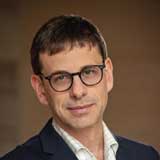
Jeffrey Veidlinger is Joseph Brodsky Collegiate Professor of History and Judaic Studies at the University of Michigan. His latest book, In the Midst of Civilized Europe: The Pogroms of 1918-1921 and the Onset of the Holocaust, was a finalist for the Lionel Gelber Prize, a finalist for the National Jewish Book Award, a Times of London "Book of the Week," and a Kirkus Top Nonfiction Book of 2021. He is also author of the award-winning books The Moscow State Yiddish Theater: Jewish Culture on the Soviet Stage (2000), Jewish Public Culture in the Late Russian Empire (2009), and In the Shadow of the Shtetl: Small-Town Jewish Life in Soviet Ukraine (2013). He was Director of the Frankel Center for Judaic Studies from 2015-2021 and Director of the Borns Jewish Studies Program at Indiana University from 2009-2013. Veidlinger has a PhD in History from Georgetown University.
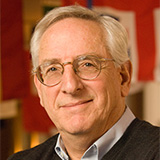
Norman M. Naimark is the Robert and Florence McDonnell Professor of East European Studies, a senior fellow of Stanford's Freeman-Spogli Institute, and a senior fellow at the Hoover Institution at Stanford University. Naimark is the author of numerous works of history, including the critically acclaimed volumes The Russians in Germany: The History of the Soviet Zone of Occupation, 1945–1949 (Harvard University Press, 1995), Fires of Hatred: Ethnic Cleansing In 20th Century Europe (Harvard University Press, 2001), Stalin's Genocides (Princeton University Press, 2010), and Genocide: A World History (Oxford University Press, 2016). His most recent book is Stalin and the Fate of Europe The Postwar Struggle for Sovereignty (Harvard University Press, 2019).
ABOUT THIS SERIES
The Bread + Medicine Speaker Series highlights conversations with historians of Russia and Ukraine and leading experts on famine and humanitarianism. It is presented in conjunction with the exhibition Bread + Medicine: Saving Lives in a Time of Famine devoted to the American famine relief mission to Soviet Russia in 1921–1923.



